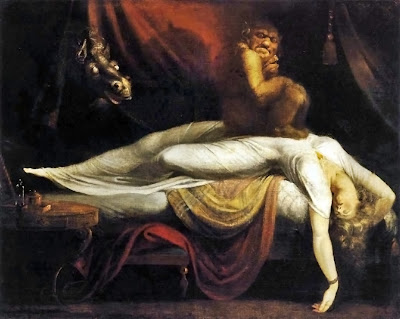the nightmare
The Nightmare - Henry Fuseli (1781)

The Nightmare simultaneously offers both the image of a dream—by indicating the effect of the nightmare on the woman—and a dream image—in symbolically portraying the sleeping vision. It depicts a sleeping woman draped over the end of a bed with her head hanging down, exposing her long neck. She is surmounted by an incubus that peers out at the viewer. The sleeper seems lifeless, and, lying on her back, she takes a position believed to encourage nightmares. Emerging from a part in the curtain is the head of a horse with bold, featureless eyes.
For contemporary viewers, The Nightmare invoked the relationship of the incubus and the horse (mare) to nightmares. The work was likely inspired by the waking dreams experienced by Fuseli and his contemporaries, who found that these experiences related to folkloric beliefs like the Germanic tales about demons and witches that possessed people who slept alone. In these stories, men were visited by horses or hags, giving rise to the terms "hag-riding" and "mare-riding", and women were believed to engage in sex with the devil. The etymology of the word "nightmare" itself is related to horses: the word is derived from mara, a Scandinavian mythological term referring to a spirit, in the form of a horse, sent to torment or suffocate sleepers. The word "mara" came from the indo-european term for horse (see also Mare (horse)#Etymology). The early meaning of "nightmare" included the sleeper's experience of weight on the chest combined with sleep paralysis, dyspnea, or a feeling of dread.
wiki
mañana si tengo ganas...la traducción.
For contemporary viewers, The Nightmare invoked the relationship of the incubus and the horse (mare) to nightmares. The work was likely inspired by the waking dreams experienced by Fuseli and his contemporaries, who found that these experiences related to folkloric beliefs like the Germanic tales about demons and witches that possessed people who slept alone. In these stories, men were visited by horses or hags, giving rise to the terms "hag-riding" and "mare-riding", and women were believed to engage in sex with the devil. The etymology of the word "nightmare" itself is related to horses: the word is derived from mara, a Scandinavian mythological term referring to a spirit, in the form of a horse, sent to torment or suffocate sleepers. The word "mara" came from the indo-european term for horse (see also Mare (horse)#Etymology). The early meaning of "nightmare" included the sleeper's experience of weight on the chest combined with sleep paralysis, dyspnea, or a feeling of dread.
wiki

Comentarios